Features and Shortcomings of the Epic Style in Khavaran Nameh and Bazel’s Hamleh Heidari
DOI:
https://doi.org/10.22046/LA.2024.02Keywords:
Sylas tics, Epic Style Language, Epic Poetry, Khavarannameh, Hamleh HeidariAbstract
One of the important functions of stylistics is to study the linguistic features of a literary genre and its changes through history. These changes, which happen as the consequences of conversion of the style, cause the features of the genre to develop or to decline. In its excellent form epic as a literary genre should offer a magnificent content to the readers through vocabulary, compounds, rhetoric and semantic structures. Accordingly, the importance of the present study is to determine the criteria of the epic language and its changes after Shahnameh and from a more precise perspective it has tried to answer the questions:
1- What are the most important features of the epic poetries in Safavi and Teimuri eras?
2- What stylistic factors have caused deficiencies of epic language in these works?
This study has been done based on library method , describing and analysing the material collected, focusing on the two works, Ibn-e Hesam’s Khavarannameh and Bazel’s Hamleh Heidari, and it comes to the conclusion that in the epic poetries after Ferdowsi because of the stylistic changes and the impact of individual poets, unfortunately a number of epic language criteria has been neglected; and the factors like rhetoric faults, lack of harmony in the music of rhythm and rhyme, the impact of Arabic language, the influence of colloquial language, unrealistic imaginations and lyric concepts have made deficiencies in its real language. Meanwhile, some of these factors are considered to be stylistic features.
References
ابنحسام (بیتا). خاورنامه، محاربات حضرتعلی(ع) مشهور به جنگنامه نسخهخطی محفوظ در کتابخانه ملی به شماره 23721.
ارسطو (1387). فن شعر، ترجمه عبدالحسین زرینکوب، تهران: امیر کبیر.
آیدنلو، سجاد (1388). متون منظوم پهلوانی«منظومههای پهلوانی پس از شاهنامه»، تهران: سمت.
باذل مشهدی، میرزا محمد رفیع ابنمحمد (بیتا). حمله حیدری، تهران: کتابفروشی اسلامی.
جمالزاده، محمدعلی (1345). کلمات عربی در شاهنامه فردوسی (صورت 865 کلمه لغت عربی در شاهنامه)، نشریه وحید، تهران، شماره 32 و شماره 30.
حاکمی، اسماعیل (1380). نکاتی پیرامون سبک شعر فارسی در دوره تیموری، ضمیمه مجله دانشکده ادبیات و علوم انسانی دانشگاه تهران، ص 65-74.
حمیدیان، سعید (1383). درآمدی بر هنر و اندیشه فردوسی، تهران: ناهید.
خالقیمطلق، جلال (1361). حماسه، تهران: دایره المعارف.
شفیعیکدکنی، محمدرضا (1358). صورخیال در شعر فارسی، تهران: آگاه.
شفیعیکدکنی، محمدرضا (1376). موسیقی شعر، تهران: آگاه.
شمیسا، سیروس (1381). نگاهی تازه به بدیع، تهران: فردوس.
شمیسا، سیروس (1383). سبک¬شناسی شعر، تهران: میترا.
شهبازی و ثابت، اصغر و مهدی (1393). نقد زبان حماسی در خاوران¬نامه ابنحسام خوسفی، جستارهای ادبی شماره 185، صص 89-117.
صفا، ذبيح االله (۱۳۶۹). حماسهسرايي در ايران، تهران: اميرکبير.
غفوریان، هانیه (1388). ادب غنایی در حماسه فردوسی، نامه پارسی، ش 50-51، صص 86-91.
غلامرضایی، محمد (1378). سبکشناسی شعر پارسی« از رودکی تا شاملو»،تهران: جامی.
میری، میرهاشم (1380). فرهنگ فارسی عامیانه، کتابخانه معلم، دوره بیستم.
نولدكه، تئودور (1327). حماسة ملي ايران، ترجمة بزرگ علوي، تهران، دانشگاه تهران.
همايي، جلالالدین (1373) فنون بلاغت و صناعات ادبي، تهران: هما.
Aristotle (1387). Fan-e She’r (trans. Abdolhossein Zarrinkub). Tehran: Amir Kabir.
Aydanlu, S. (1388). Matn-hā-ye manẓūm-e pahlavānī: Manẓūma-hā-ye pahlavānī pas az Shāhnāme. Tehran: SAMT.
Bazl Mashhadi, M. M. R. b. Mohammad. (n.d.). Hamla-ye Heydari. Tehran: Ketabforushi-ye Eslami.
Ebn-e Hessam. (n.d.). Khāvar-nāme, mohārabāt-e Hazrat ʿAlī (ʿa) mashhūr be Jang-nāme. Manuscript, National Library of Iran, No. 23721.
Ghafourian, H. (1388). Adab-e ghanāʾī dar ḥamāse-ye Ferdowsī. Nāme-ye Pārsi, 50–51, 86–91.
Gholamrezai, M. (1378). Sabk-shenāsī-ye sheʿr-e Fārsi: az Rudakī tā Shāmlū. Tehran: Jami.
Hakemi, E. (1380). Nokātī pīrāmun-e sabk-e sheʿr-e Fārsi dar dore-ye Tīmūrī. Supplement of Faculty of Letters and Humanities, University of Tehran, 65–74.
Hamidiyan, S. (1383). Darāmadi bar honar va andīshe-ye Ferdowsī. Tehran: Nahid.
Homai, J. (1373). Fonūn-e belāghat va ṣanāʿāt-e adabī. Tehran: Homa.
Jamalzadeh, M. A. (1345). Kalāmāt-e ʿArabī dar Shāhnāme-ye Ferdowsī (ṣūrat-e 865 kaleme). Vahid Journal, 30 & 32. Tehran.
Khaleghi-Motlaq, J. (1361). Ḥamāse. Tehran: Da’erat al-Ma’aref.
Miri, M. H. (1380). Farhang-e Fārsi-ye ʿāmiyāne (Vol. 20). Tehran: Ketabkhane-ye Moallem.
Nöldeke, T. (1327). Ḥamāsa-ye mellī-ye Irān (trans. Bozorg Alavi). Tehran: University of Tehran.
Safa, Z. (1369). Ḥamāse-sarāʾī dar Irān. Tehran: Amir Kabir.
Shafiei-Kadkani, M. R. (1358). Ṣovar-e khīāl dar sheʿr-e Fārsi. Tehran: Agah.
Shafiei-Kadkani, M. R. (1376). Mūsīqī-ye sheʿr. Tehran: Agah.
Shahbazi, A., & Sabet, M. (1393). Naqd-e zabān-e ḥamāsī dar Khāvar-nāme-ye Ebn-e Hessam-e Khusfī. Jostarhā-ye Adabi, (185), 89–117.
Shamisa, S. (1381). Negāhī tāze be badīʿ. Tehran: Ferdows.
Shamisa, S. (1383). Sabk-shenāsī-ye sheʿr. Tehran: Mitra.
Downloads
Published
How to Cite
Issue
Section
License
Copyright (c) 2023 Sedighe Karimi

This work is licensed under a Creative Commons Attribution 4.0 International License.

